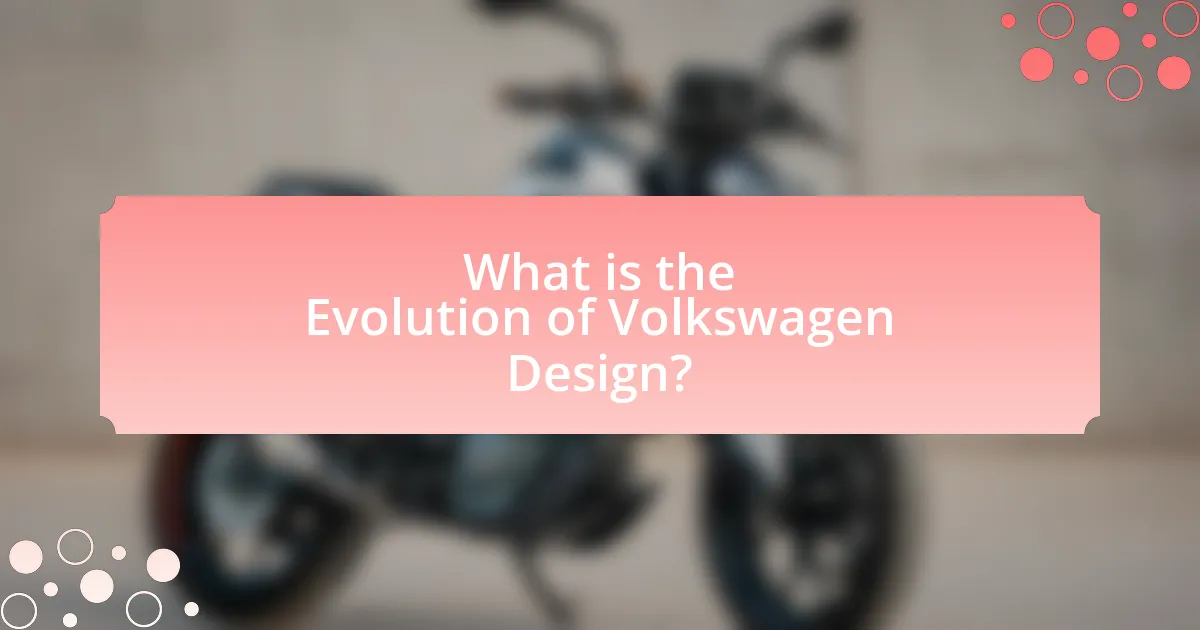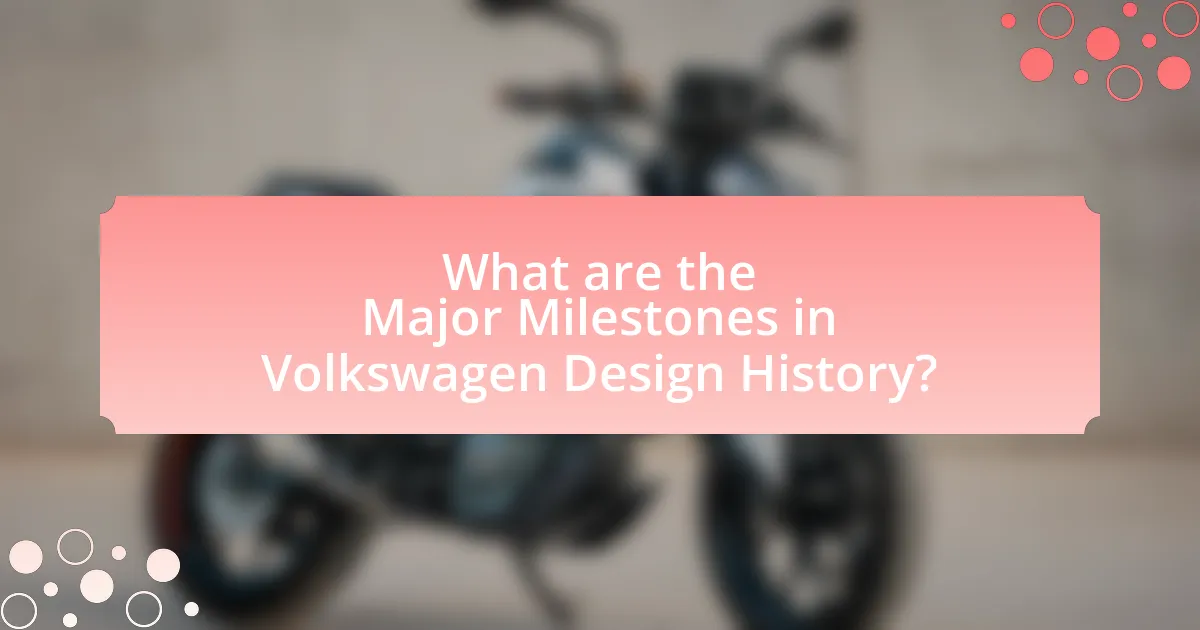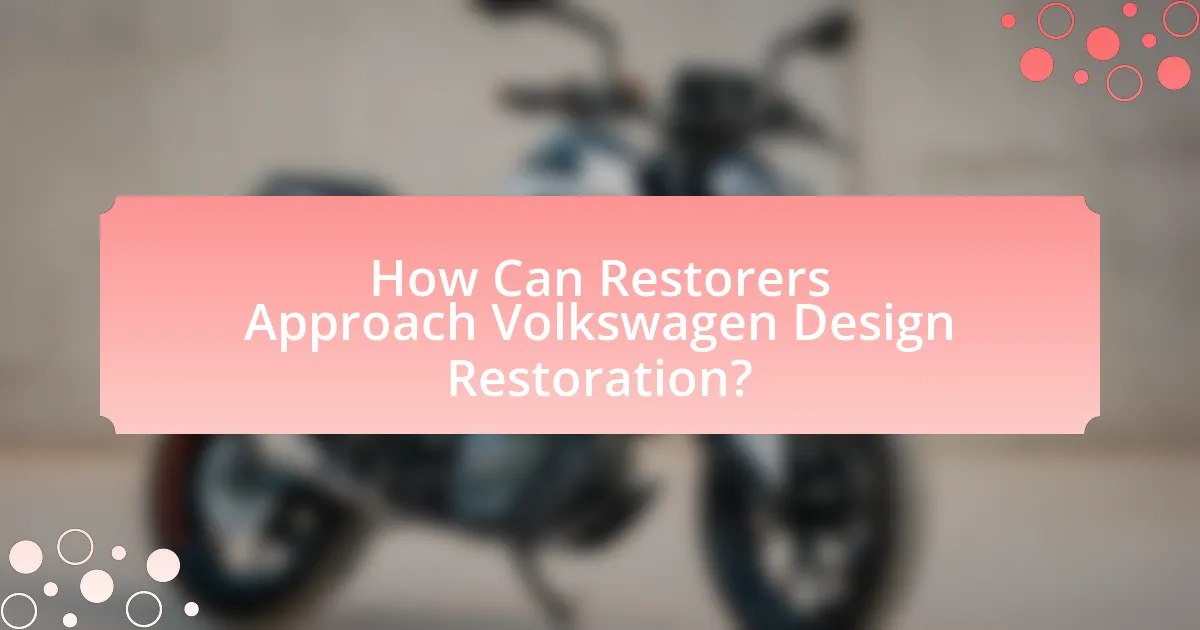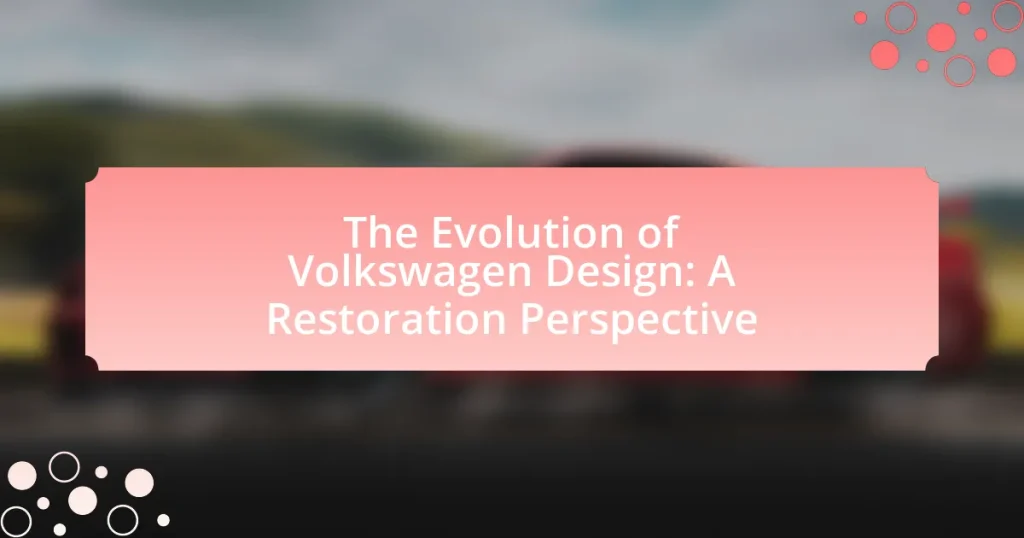The article focuses on the evolution of Volkswagen design, tracing its journey from the iconic Beetle to contemporary electric vehicles. It highlights key milestones in design history, such as the introduction of the Type 2 Bus and the Golf, and examines how cultural and technological shifts have influenced Volkswagen’s design philosophy. The article also emphasizes the importance of understanding design evolution for restorers, detailing best practices for maintaining authenticity in restoration projects, sourcing original parts, and replicating finishes. Additionally, it discusses the impact of design evolution on the value of restored Volkswagen vehicles, providing insights into the significance of historical context and design principles in the restoration process.

What is the Evolution of Volkswagen Design?
The evolution of Volkswagen design reflects a progression from the iconic Beetle to modern electric vehicles, showcasing a blend of functionality and aesthetic appeal. Initially, the Beetle, designed in the 1930s by Ferdinand Porsche, emphasized simplicity and efficiency, becoming a symbol of the brand. In the 1960s and 1970s, Volkswagen expanded its design language with models like the Type 2 Bus, which embraced a more playful and utilitarian approach.
The 1990s introduced a more contemporary design ethos with the introduction of the Golf, characterized by sharper lines and a focus on aerodynamics. In the 2000s, Volkswagen adopted the “design DNA” concept, leading to a cohesive look across its lineup, exemplified by the New Beetle and the Passat.
Recent years have seen a shift towards electric mobility, with models like the ID.3 and ID.4, which incorporate sustainable design principles and advanced technology. This evolution is supported by Volkswagen’s commitment to innovation, as evidenced by their investment in electric vehicle development and the introduction of the Modular Electric Drive Matrix (MEB) platform, which allows for versatile design across various models.
How has Volkswagen’s design philosophy changed over the decades?
Volkswagen’s design philosophy has evolved significantly from the utilitarian and iconic shapes of the mid-20th century to a more modern, streamlined aesthetic focused on sustainability and technology. Initially, Volkswagen emphasized simplicity and functionality, exemplified by the Beetle’s rounded form and air-cooled engine, which became a symbol of the brand in the 1930s. Over the decades, particularly in the 1990s and 2000s, the company began to incorporate more dynamic and aggressive styling, as seen in models like the Golf and Passat, reflecting changing consumer preferences for sportiness and performance.
In recent years, Volkswagen has shifted towards a design language that prioritizes electric mobility and digital integration, as demonstrated by the introduction of the ID. series, which features clean lines and a focus on aerodynamics to enhance efficiency. This transition aligns with global trends towards sustainability and innovation in the automotive industry, showcasing Volkswagen’s commitment to adapting its design philosophy to meet contemporary demands while maintaining its heritage.
What key design elements have remained consistent throughout Volkswagen’s history?
Volkswagen’s design has consistently featured several key elements, including the iconic rounded shape, the use of simple and functional lines, and the distinctive front grille. The rounded shape, first popularized by the Beetle in the 1930s, has remained a hallmark of Volkswagen’s identity, emphasizing a friendly and approachable aesthetic. Simple and functional lines reflect the brand’s commitment to practicality and efficiency, evident in models like the Golf and Passat. The distinctive front grille, often characterized by horizontal slats, has been a unifying design feature across various models, reinforcing brand recognition. These elements have contributed to Volkswagen’s enduring appeal and have been integral to its design philosophy throughout its history.
How have cultural and technological shifts influenced Volkswagen’s design?
Cultural and technological shifts have significantly influenced Volkswagen’s design by driving innovation and adapting to consumer preferences. For instance, the rise of environmental consciousness led Volkswagen to develop electric vehicles, such as the ID. series, reflecting a commitment to sustainability. Additionally, advancements in manufacturing technology, like automation and 3D printing, have allowed for more complex and efficient designs, enhancing both aesthetics and functionality. Historical context shows that the introduction of the Beetle in the 1930s was a response to the need for affordable transportation, while modern designs incorporate digital interfaces and connectivity features to meet contemporary consumer demands.
Why is understanding Volkswagen’s design evolution important for restorers?
Understanding Volkswagen’s design evolution is crucial for restorers because it enables them to accurately replicate the original specifications and aesthetics of the vehicles. This knowledge allows restorers to identify the specific design features, materials, and manufacturing techniques used in different eras of Volkswagen production, ensuring authenticity in restoration projects. For instance, the transition from the classic Beetle’s rounded shapes to the more angular designs of later models reflects significant changes in automotive design philosophy and technology. By comprehending these shifts, restorers can source appropriate parts and apply correct restoration methods, thereby preserving the historical integrity and value of the vehicles.
What insights can restorers gain from studying Volkswagen’s design history?
Restorers can gain valuable insights into authenticity, design evolution, and manufacturing techniques by studying Volkswagen’s design history. Understanding the original design principles, such as the iconic Beetle’s simplicity and functionality, allows restorers to maintain the vehicle’s integrity during restoration. Additionally, knowledge of the various design phases, including the transition from air-cooled to water-cooled engines, informs restorers about the technical changes and materials used over time. Historical context, such as the impact of World War II on production methods and design choices, further enhances a restorer’s ability to create an accurate representation of the vehicle. This comprehensive understanding ensures that restorations are not only visually accurate but also true to the engineering and cultural significance of Volkswagen’s legacy.
How does design evolution impact the value of restored Volkswagen vehicles?
Design evolution significantly enhances the value of restored Volkswagen vehicles by aligning them with contemporary aesthetic and functional preferences. As Volkswagen models have undergone various design changes over the decades, restored vehicles that incorporate these modern elements tend to attract higher prices in the collector market. For instance, classic models like the Volkswagen Beetle have seen increased value when restored to reflect popular design trends, such as updated paint colors and interior materials that resonate with current consumer tastes. Historical data indicates that well-restored models that embrace design evolution can command prices that are 20-30% higher than those that remain strictly true to their original specifications, demonstrating the financial impact of design adaptation on restoration value.

What are the Major Milestones in Volkswagen Design History?
The major milestones in Volkswagen design history include the introduction of the Beetle in 1938, which became an iconic symbol of automotive design, followed by the launch of the Type 2 (Volkswagen Bus) in 1950, which revolutionized the concept of utility vehicles. In 1974, the Golf was introduced, marking a shift towards compact cars and establishing a new design language for the brand. The introduction of the New Beetle in 1997 revitalized the classic design for a new generation. Each of these milestones reflects significant changes in consumer preferences and technological advancements, solidifying Volkswagen’s position in automotive history.
Which iconic models represent significant design changes for Volkswagen?
The iconic models that represent significant design changes for Volkswagen include the Volkswagen Beetle, the Volkswagen Golf, and the Volkswagen ID.4. The Volkswagen Beetle, introduced in the 1930s, revolutionized automotive design with its distinctive rounded shape and rear-engine layout, becoming a symbol of the brand. The Volkswagen Golf, launched in the 1970s, marked a shift towards a more modern, compact hatchback design that emphasized practicality and efficiency, leading to its status as one of the best-selling cars globally. The Volkswagen ID.4, released in 2020, signifies a major transition to electric vehicles, showcasing a contemporary design focused on sustainability and advanced technology, reflecting the brand’s commitment to future mobility. These models collectively illustrate Volkswagen’s adaptability and innovation in automotive design over the decades.
What features made the Beetle a design icon?
The Volkswagen Beetle became a design icon due to its distinctive rounded shape, simple and functional design, and innovative engineering. The rounded silhouette, characterized by its bulbous body and sloping roofline, contributed to its unique aesthetic appeal and aerodynamic efficiency. Additionally, the Beetle’s air-cooled rear-engine layout and compact size made it practical for urban environments, enhancing its popularity. The design was further solidified by its cultural significance, as it became a symbol of the counterculture movement in the 1960s. These features combined to create a vehicle that was not only visually striking but also functional and culturally resonant, establishing the Beetle as a lasting design icon in automotive history.
How did the introduction of the Golf redefine Volkswagen’s design approach?
The introduction of the Golf in 1974 redefined Volkswagen’s design approach by establishing a new standard for compact cars that emphasized practicality, efficiency, and modern aesthetics. The Golf’s design, characterized by its hatchback format and versatile interior, shifted Volkswagen’s focus from traditional, boxy shapes to more fluid and functional designs that appealed to a broader audience. This change was significant as it marked the beginning of a new era for Volkswagen, where user-centered design became paramount, leading to the development of subsequent models that prioritized both form and function, ultimately contributing to the brand’s global success.
What role did design competitions and collaborations play in Volkswagen’s evolution?
Design competitions and collaborations significantly influenced Volkswagen’s evolution by fostering innovation and enhancing brand identity. These initiatives allowed Volkswagen to engage with diverse design perspectives, leading to iconic models such as the Volkswagen Beetle, which emerged from a collaborative design process in the 1930s. The company’s participation in competitions, like the 1950s “Design for the Future” contest, encouraged creative solutions that aligned with changing consumer preferences and technological advancements. This approach not only solidified Volkswagen’s reputation for quality and design but also resulted in vehicles that resonated with a global audience, ultimately contributing to the brand’s enduring legacy in the automotive industry.
How have partnerships with designers influenced Volkswagen’s aesthetic direction?
Partnerships with designers have significantly influenced Volkswagen’s aesthetic direction by introducing innovative design concepts and enhancing brand identity. Collaborations with renowned designers, such as the partnership with Italian designer Giorgetto Giugiaro, led to iconic models like the Golf and Scirocco, which emphasized a blend of functionality and style. These collaborations have allowed Volkswagen to incorporate cutting-edge design elements, resulting in vehicles that not only meet consumer needs but also reflect contemporary design trends. The impact of these partnerships is evident in the evolution of Volkswagen’s design language, which has shifted towards a more modern and dynamic aesthetic, aligning with global automotive design standards.
What notable design competitions has Volkswagen participated in?
Volkswagen has participated in several notable design competitions, including the prestigious Red Dot Design Award and the iF Design Award. The Red Dot Design Award, established in 1955, recognizes excellence in design across various categories, and Volkswagen has received multiple accolades for its innovative vehicle designs. Similarly, the iF Design Award, which has been awarded since 1953, honors outstanding design achievements, and Volkswagen has been recognized for its commitment to quality and creativity in automotive design. These competitions highlight Volkswagen’s dedication to advancing design standards in the automotive industry.

How Can Restorers Approach Volkswagen Design Restoration?
Restorers can approach Volkswagen design restoration by adhering to original specifications and utilizing authentic parts to maintain the vehicle’s historical integrity. This method ensures that the restoration reflects the original design and engineering principles established by Volkswagen, which are crucial for preserving the vehicle’s value and authenticity. For instance, using OEM (Original Equipment Manufacturer) parts and following factory service manuals can significantly enhance the accuracy of the restoration process. Additionally, restorers should document the restoration process meticulously, as this documentation serves as proof of authenticity and can increase the vehicle’s market value.
What are the best practices for restoring classic Volkswagen models?
The best practices for restoring classic Volkswagen models include thorough research, sourcing authentic parts, and maintaining original specifications. Researching the specific model’s history and design nuances ensures that restorers understand the vehicle’s unique characteristics and requirements. Sourcing authentic parts is crucial, as using original or OEM components preserves the vehicle’s integrity and value; for instance, using parts from reputable suppliers like Wolfsburg West or CIP1 can enhance authenticity. Maintaining original specifications during restoration, such as adhering to factory paint codes and interior materials, helps retain the classic aesthetic and market value, as evidenced by the higher resale prices of vehicles that remain true to their original design.
How can restorers ensure authenticity in their restoration projects?
Restorers can ensure authenticity in their restoration projects by adhering to original specifications and using period-correct materials. This approach involves thorough research into the specific model’s design, components, and manufacturing processes, which can be validated through original factory documentation and historical records. For instance, restorers of classic Volkswagen models often reference the Volkswagen factory manuals and parts catalogs from the era to source authentic parts and replicate original finishes. This commitment to accuracy not only preserves the vehicle’s historical integrity but also enhances its value in the collector market, as authenticity is a key factor in appraisals and sales.
What resources are available for researching original design specifications?
Resources available for researching original design specifications include manufacturer archives, automotive history libraries, and online databases. Manufacturer archives, such as those maintained by Volkswagen, often contain original design documents, specifications, and engineering drawings. Automotive history libraries, like the Henry Ford Museum or the Petersen Automotive Museum, provide access to historical records and publications related to vehicle design. Online databases, such as the Internet Archive or specialized automotive forums, can offer digitized documents and community-contributed information on original specifications. These resources collectively support accurate restoration efforts by providing verified historical data.
What common challenges do restorers face when working on Volkswagen vehicles?
Restorers face several common challenges when working on Volkswagen vehicles, including sourcing authentic parts, dealing with rust and corrosion, and navigating the complexities of vintage electrical systems. Sourcing authentic parts is difficult due to the limited availability of original components for older models, which can lead to the use of aftermarket parts that may not fit or function as intended. Rust and corrosion are prevalent issues in many vintage Volkswagens, requiring extensive bodywork and sometimes complete panel replacements to restore structural integrity. Additionally, the vintage electrical systems in these vehicles often require specialized knowledge to troubleshoot and repair, as they differ significantly from modern automotive wiring. These challenges are compounded by the need for restorers to maintain the vehicle’s original aesthetic and functionality, making the restoration process both time-consuming and labor-intensive.
How can restorers overcome issues related to sourcing original parts?
Restorers can overcome issues related to sourcing original parts by establishing strong networks with specialized suppliers and utilizing online marketplaces dedicated to vintage automotive parts. These networks often include connections with other restorers, collectors, and enthusiasts who can provide leads on hard-to-find components. For instance, platforms like eBay Motors and dedicated forums for Volkswagen enthusiasts frequently list original parts, making them accessible to restorers. Additionally, restorers can attend automotive swap meets and shows, where they can find original parts directly from other collectors. This approach not only increases the chances of finding authentic components but also fosters a community that shares knowledge and resources, enhancing the restoration process.
What techniques can be used to replicate original finishes and materials?
Techniques to replicate original finishes and materials include using period-accurate paints, applying authentic wood veneers, and employing traditional upholstery methods. For instance, automotive restorers often utilize single-stage or two-stage paint systems that match the original color codes provided by manufacturers, ensuring fidelity to the original appearance. Additionally, sourcing materials like genuine leather or period-correct fabrics for upholstery helps maintain authenticity. Techniques such as hand-rubbed finishes or the use of specific varnishes can also replicate the original sheen and texture of surfaces. These methods are validated by restoration experts who emphasize the importance of using original specifications to achieve accurate restorations.
What tips can enhance the restoration process for Volkswagen enthusiasts?
To enhance the restoration process for Volkswagen enthusiasts, meticulous planning and sourcing quality parts are essential. Enthusiasts should begin by thoroughly researching the specific model they are restoring, as this knowledge helps in identifying authentic parts and understanding the vehicle’s unique characteristics. Utilizing reputable suppliers for parts ensures that restorations maintain originality and quality, which is crucial for preserving the vehicle’s value. Additionally, documenting the restoration process with photographs and notes can provide valuable insights for future projects and help maintain the vehicle’s history. Engaging with the Volkswagen community through forums and clubs can also offer support, advice, and resources that can significantly improve the restoration experience.


